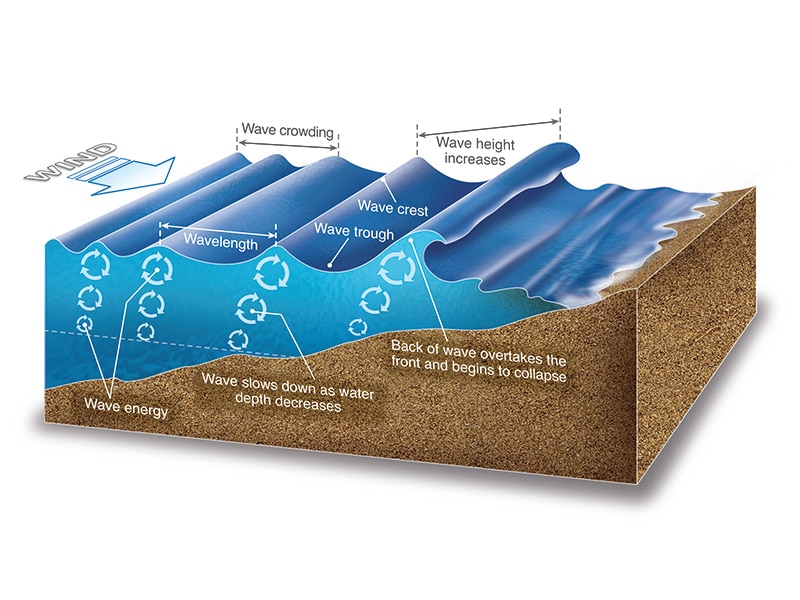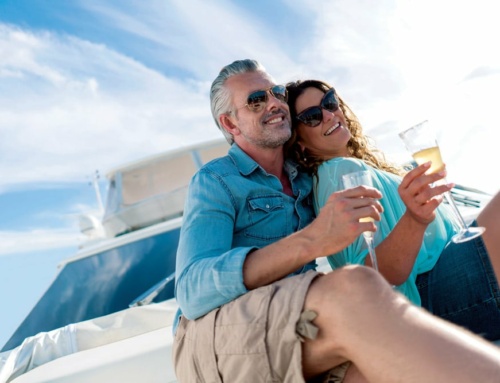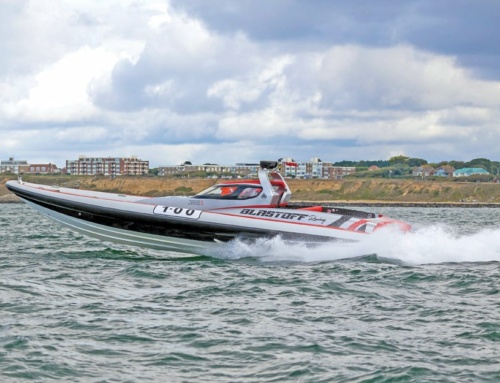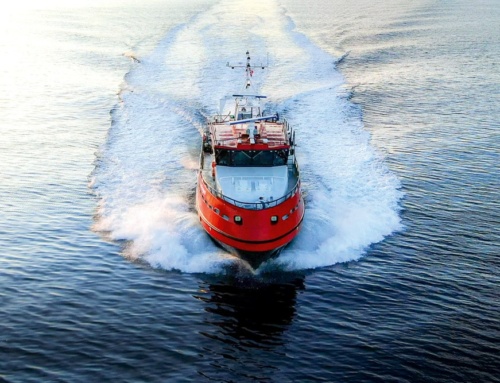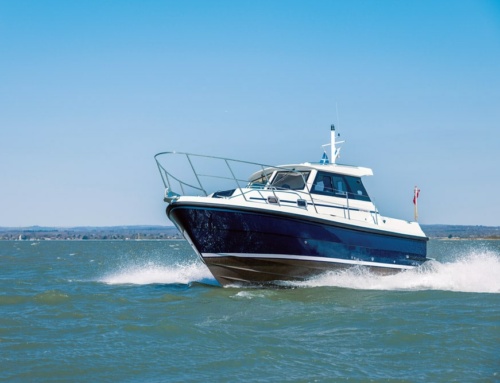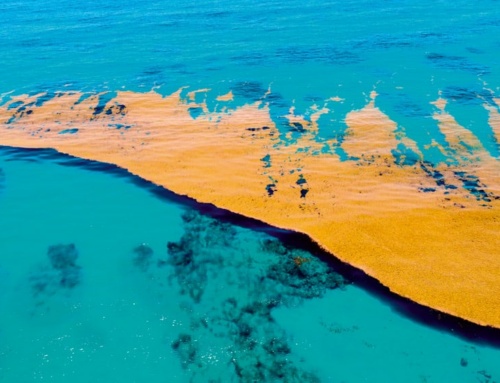- Ahead of going afloat, research likely wind and wave conditions and look for tidal information.
- Bring all of this knowledge, together with a chart of your intended passage area, to try to predict what you may face.
- You will never get it 100% right, but preparation and research will make for a far better outcome generally than none at all.
Being capable of handling more challenging conditions comes from a mixture of understanding the principles of boat handling in rougher conditions and getting hands-on experience alongside those more experienced than you. Paul Glatzel explains why it can be really beneficial to have a knowledge of waves, how they develop and their characteristics …
Waves are generated in two main ways. Wind-driven waves arise from the combination of wind speed, the distance of water over which the wind blows (the ‘fetch’) and the length of time it has blown for (the ‘duration’). Waves can also be generated by the horizontal flow of water across an uneven seabed. This flow of water is caused by tides, with the magnitude of any waves generated being influenced by the rate of the tide and how the seabed changes. Waves can be generated from the forces of wind and tide alone or magnified by the combination of the two coupled with other factors that can influence the waves we face as boaters. In this article, we’ll seek to provide some background theory and put you in a position to predict what you may face when afloat.
Wind generates two types of waves of relevance to us as boaters – ‘sea waves’ (or ‘wind waves’) and ‘swell waves’ (generally just referred to as ‘swell’). Sea waves are created by the direct effect of wind in a local area. The waves are generally irregular and it can be difficult to work out their direction or wavelength. The wave height can be up to 10m.
Swell arises from the remnants of sea waves and can travel significant distances from where the original waves were generated. Swell can have heights of as much as 10‒20 m and its pattern and direction are regular and easier to determine. Sea waves can develop on top of swell, and if there is a change in wind direction you could get multiple patterns of sea waves built on swell waves.
When considering waves, it’s handy to understand some of the terminology that is applied to them.
Wave height is the height from the bottom of a ‘trough’ to the top of a ‘crest’, while the ‘wavelength’ is the distance from one crest to another and the ‘period’ the time between crests at a fixed point.
As already touched on, waves develop over time due to the wind strength, duration and fetch. There comes a point, though, where these waves are ‘fully developed’ and can grow to no greater height unless the wind strength increases. A ‘wave train’ is a group of similar-sized waves travelling in the same direction.
There are various terms applying to wave heights and it can be handy to understand some of the common ones. A commonly quoted figure will be the ‘average wave height’ (HAV). As its name suggests, this is an average of every wave. Of more interest can be the ‘significant wave height’ (SWH). This is the average of the largest third of all of the waves. Its value is typically 1.6x HAV. Finally, data can be available for the highest tenth of the waves (H1/10); this is typically about 2x HAV.
There is often talk in the press of boaters being caught out by ‘rogue waves’. Are these really rogue or are they just some of the bigger waves that are entirely predictable given the relationship referred to above between average-sized waves and those in the top 10% of those likely to be experienced? Recent research at Oxford University revealed that extremely large rogue waves can be created where two wave trains interact at an angle of about 120°, so certainly they do happen, but it’s worth remembering when out in any sea that for every few regular-sized waves some could be far bigger. Sites like Magicseaweed.com make the data available for wave data buoys and will make some of these statistics referred to available.
As waves get closer to shore and/or the depth of water reduces, the waves slow down due to the effect of friction with the seabed. The waves become higher and steeper and eventually collapse. These are ‘breakers’ and there are three main types of relevance to us:
‘Spillers’ occur when a wave breaks as it moves inshore and energy is released gradually.
‘Plungers’ occur when the wave collapses in a short period of time; the energy release is sudden and can be highly dangerous.
‘Surging’ breakers occur with steep bottom slopes like a beach.
All breaking waves have the potential to be dangerous, but the considerable energy in a plunger means that for a boater extreme care needs to be taken when faced with one. Looking at the wave, the part just about to break is where most of the energy is, but the ‘shoulder’ area is building towards being a plunger and could be a very dangerous area to approach. The area that has already broken is dissipating its energy really fast and is effectively now a ‘spiller’.
The other factor that is going to materially influence the conditions you face is the topography of the location.
In the image you can see waves being affected by the headlands, islands and sea walls. These effects are predictable, so knowing the wind direction and consulting a chart gives you the chance to predict how waves will react to these structures. Don’t forget tide, though, as if the tide is running with the wind this can have a flattening effect, whereas wind against tide can create more challenging conditions.
When considering tidal stream, remember that with spring tides roughly twice the volume of water needs to flow compared to a neap tide, so the rate at springs will be roughly twice that of neaps too.
Also, remember that this greatest flow will be in the mid two hours of the rise or fall when 50% of the range will flow. The flow of tide through constrictions and around headlands leads to an increase in the rate of flow, and any undulations on the seabed will give rise to standing waves directly above these undulations. Add in the wind and some truly catastrophic seas can arise (on YouTube, search ‘Portland Bill huge storm’ for a great example).
Sea state vs wind strength
As already mentioned, the strength/speed of the wind has a direct bearing on the magnitude of the waves created. It is pretty well known that the wind strength is explained by referring to the ‘Beaufort Scale’. The Beaufort Scale ranges from F0 to F12, and each force has an associated wind speed range and description (e.g. F4, 11‒16 knots, ‘moderate breeze’). Most wind strength tables also detail likely wave heights to be associated with these forces with descriptions such as ‘moderate’, ‘rough’ or ‘very rough’ and associated likely wave heights in meters (indeed these terms are used in marine forecasts such as the inshore waters forecast). These descriptions relate to an equivalent scale for ‘sea state’ called the ‘Douglas Scale’; these sea states range from 0 to 9. Sea state should not be confused with wind strength as you could easily get a situation where the wind strength maybe F8, yet the fact that the wind hasn’t been blowing for long (duration) and is only blowing over a short distance (fetch) means that the sea state is only 3 or 4. Therefore, if you were describing the conditions in an area you might say ‘SW F6, sea state 4–5’. Commenting on wind strength and sea state together means a whole lot more than just the wind strength. To be able to do this you need to have access to a sea state table. The RNLI has a good table at http://completeguide.rnli.org/sea-state.html.
Understanding a bit about waves sets you up well when you start to explore the challenges of boat handling in rougher conditions. Learn to read the waves, identify their types, look at the way that they are developing and work out where the energy and thus the danger is.
Ahead of going afloat, research likely wind and wave conditions and look for tidal information. Bring all of this knowledge, together with a chart of your intended passage area, to try to predict what you may face. You will never get it 100% right, but preparation and research will make for a far better outcome generally than none at all. And remember, whatever your research throws up, always be prepared to dynamically assess what you are actually facing and change your mind. Good skippers prepare but also know when to overrule an initial decision, not go out or head elsewhere.
| The RYA Advanced Powerboat Handbook is available for £16.99 from the RYA shop. It is also available as an e-book using the RYA app. |
Paul Glatzel is an RYA Powerboat Trainer and Examiner and is based in Poole in Dorset. He runs Powerboat Training UK and is author of the RYA Powerboat Handbook and the RYA Advanced Powerboat Handbook.

